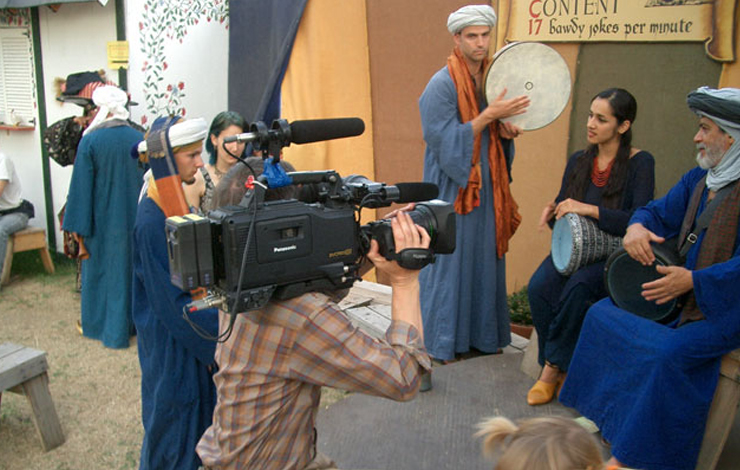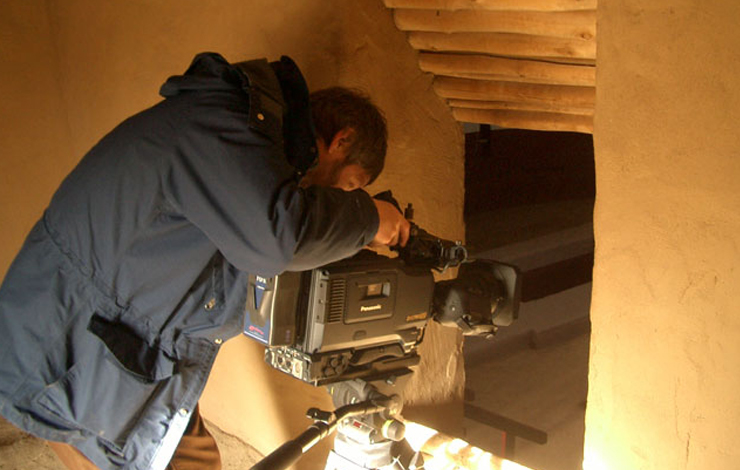
Returning from the 82nd Annual Inter-Tribal Indian Ceremonial in Gallup, New Mexico, in August 2002, with nine hours of DV-cam footage shot on my Sony PD150, I had the intent to return in August 2003 to complete a documentary of this oldest American Indian arts event in the world. With Indian dancing and rodeo held in an arena surrounded by the spectacular red sandstone cliffs of Red Rock State Park, and Indian artists selling their art in the main building and surrounding courtyard, Ceremonial––ls it is referred to by Indians and art collectors alike--is a visual extravaganza for those interested in Indian arts and culture.
With almost 20 years of experience in selling Indian art, and having produced two dozen Indian art shows, I felt I might attempt to do justice to the vast topic of Indian art with a documentary about the Ceremonial.
I wanted to shoot in 16:9 format, and I wasn't about to use an anamorphic lens, which precludes telephoto and close-up shots—both essential to the subject matter. Indian art and culture is very much appreciated in Europe, and also in Japan, and these countries all use a wide-screen format. Europe also has a 25-per-second frame rate, not the 30 frames of NTSC, so I concluded that I also needed to shoot in 24p––currently the nearest thing to an international format.
My first thought was to shoot in High Definition. Since the event only lasts five days, I considered renting an HD outfit for a week. Then I got more ambitious, and asked Mike Caporale if he would be director of photography and shoot on his Panasonic AJ-HDC27F Varicam, which, with its slow-motion capability, would be ideal for the Indian dances and rodeo. I would also rent a second Varicam.
Before December 2002, my choice of native 16:9 chip cameras capable of 24p frame-rate was limited to two HD cameras—the Sony F900 Cine Alta and the Panasonic 27F Varicam. At DVExpo in Los Angeles in December 2002, I saw a mock-up of the new Panasonic SD camera, the AJ-SDX900. Four months later, at the National Association of Broadcasters show, I was captivated by the extraordinary quality of some footage from that camera.
In June 2003, the Ceremonial board officially declined my offer to make a movie about their event, so I called the organizers of the second oldest Indian art show in the USA—the Santa Fe Indian Market, one year younger than Ceremonial-and got a very positive response. Next I approached the Whitehawk company, producers of the best show for antique Indian art in the world, also set in Santa Fe, a week before Indian Market. Another positive response.
Deciding that coverage of more shows would make my documentary less of an info-mercial and therefore more saleable, especially to television, I was happy for the change. But my shoot was now up from five days to 30 days, and I needed at least two cameras for the first week. Yet the cost of renting two HD camera outfits was a daunting $20,000.
Renting two Panasonic AJ-SDX900 camera outfits for a month would have cost about $13,000, but I couldn't find any rental houses with them yet. Thinking ahead, I calculated that if I only did one month-long shoot a year, in just over two years I would pay $39,000 in rental fees! At this point, I seriously considered finishing the movie using my PD150 and PD100A DV-cams, with a couple of assistants, for modest outlay.

But my conclusion was to purchase; owning the cameras would certainly stop my prevarications as to whether I wanted to be a full-time movie-maker. With $100,000 invested in equipment, I'd better make a go of it!
I purchased two Fujinon lenses—the 22x7.8, which, with the in-built 2x converter, would enable really tight close-ups of the dancers and rodeo in the arena; and the really wide 13x4.5, also with 2x converter, for scenics, hand-held crowd scenes and tight interiors. Each lens was in EFP configuration, with servo zoom and focus motors.
Originally, I balked at the huge cost of two good tripods, and tried to economize with lesser brands, but was saved by Vinten. Since I review equipment for various magazines, I was hoping to review the new, immensely rigid Fibertec tripod from Vinten, which I saw at DVExpo in New York. But none were available, so in the meantime, Vinten shipped me a carbon-fiber Pozi-Loc tripod with the Vision 100 head.
Comparing the Vinten Vision 100 head to others (all similar in price) left me with much respect for this excellent English-made tripod. Both the pan and tilt locks on the Vision 100 head are together on the left side of the head, and can be applied or released very positively with one-finger pressure without jarring the camera, and the balance and smoothness are perfection itself. Even the budget-priced Vision 3, on aluminum sticks, seems sturdier and has a better feel than similarly-priced competitors.
Although we drove to and from the Southwest for my Indian arts doc, I did fly with my equipment to Washington, DC, later in the year, and ran into the horrors of not having the right carry-on case for a camera of this size. Kata, I discovered later, makes the only airline-legal carry-on case (model TCCT) that can both carry the SDX900 (or Varicam) in flight, and expand into a location case at the pull of a zipper.
Tiffen UV filters were used on the lenses to protect the front elements from flying dust, as well as to cut UV in scenic shots; polarizing filters were also used, both to darken blue skies and to remove glare from surfaces. For example, a polarizing filter can make an otherwise almost invisible petroglyph pop out of the ancient weathering of the rock, as I discovered at the Petroglyph National Monument in Albuquerque.
While recording petroglyphs, I carried the 13-pound Vinten tripod in one hand, and the AJ-SDX900 (about 16 pounds ready to go) in the other hand for about three miles over undulating countryside, in the hot New Mexico sun—a tiring experience. I researched backpacks, and concluded again that Kata made the best one. It even takes a detachable "insert" trolley.
For batteries, there was nothing that compared with the IDX system. I bought four of the 82 Watt batteries, plus four small (50 watt) batteries, and two of the less expensive chargers, just so I'd have a second charger, rather than one unit to charge all batteries.
I chose the IDX batteries that clip together. Not only will two batteries double the battery capacity, but as this drains the end battery first, the camera assistant can even hot-swap to a fresh battery mid-shot. Add that to the fact that with the two sizes of stackable batteries, virtually any lens, matte box or image stabilizer can be adequately counter-balanced.
My microphones of choice were the Audio-Technica AT835ST. This stereo mic enables recording to be done either in true stereo, or recording at split levels (one set to higher sensitivity, one to lower) to be sure there will always be good audio to which to cut. I bought four of these mics—one for each of my SDX900 cameras, one for Mike's Varicam (he liked it enough to keep it) and one for my boom pole.
After taking one of the excellent courses on location audio offered by Filmmakers Central (FMC) at Wilcox Sound in Burbank, California, I had Wilcox make up a couple of its carbon-fiber boompoles specially equipped with stereo cables for the AT mics, which we used in AT shock mounts.
My van carried Arri 650-watt and Pepper 150-watt spotlights, and a seven-foot diameter Photoflex Octodome for the Starlite head. These weren't used, but I did use Lowel CaseLite units, both two-tube and four-tube models, on location when I wanted soft, cool-running lighting, that due to low current draw, can be plugged in almost anywhere. Both CaseLites were fitted with daylight color temperature tubes, so they could act as fill lights to daylight, yet only lose half a stop if gelled to match tungstem. One evening session ended when a horse galloped by and disconnected the power cable to the house while we were recording a Navajo weaver. Fortunately I never go anywhere in the dark without a flashlight.
I really like the richness of the image quality of the Panasonic AJ-SDX900, but being used to a Sony PD150 (which now seems featherweight in comparison), I was less happy about the size and weight of a broadcast camera. After some days of several hours of handheld shooting, I wondered how to reduce the stress on my body.
Though too late for this shoot, the answer is the EasyRig, which redistributes the weight of a heavy camera to the torso and hips, making long hand-held shoots much easier, and steadies the camera as well. For even more image stability, I've recently tried the Canon IS-20 image stabilizer that fits in front of the lens, in conjunction with the EasyRig. The results are quite impressive. I am now able to go handheld without shoulder or elbow strain, and get smoother shots even in telephoto mode.
When Panasonic introduced the new DVX100A I tested it to see if it would inter-cut well enough with the AJ-SDX900. Initial tests suggest that the picture "look" can be matched well. I shot in the "Squeeze" mode—a kind of electronic anamorphic, if you will. I won't use an anamorphic lens; after all, I've got a really good native 16:9 chip camera in the AJ-SDX900.
The Scottish company AccuScene have developed a color viewfinder for the Sony Cine Alta, and Panavision have placed a sizable order. David McIntosh, president and CEO of AccuScene, says that he is working on one for the Panasonic Varicam, and that with software changes, this may be available for the SDX900. Distinctly sharper than existing monochrome viewfinders, the AccuScene viewfinder incorporates an exposure metering option that also aids precise focusing. Another recent acquisition, also unavailable for the summer shoot, is the new Panasonic BT- LH900 LCD monitor, which accepts HD/SDI, and has a waveform monitor that shows (in real time) below the picture, to ensure spot-on exposure. I purchased my own Panasonic AJ-SD930 deck, as I want to use it whenever I need, and without the hassle of renting. I had the optional Firewire output board installed, so I can edit on Final Cut Pro 4, which automatically extracts the 24 frames from the 24pA (for Advanced) recording mode in a special 3:2:2:3 pull-down.
So far, I have over 60 hours of footage for Indian Art Summer; I have also covered the Hot Air Balloon Rally in the same Red Rock State Park and have another documentary—on the dance group Hahbi Ru--also in process, all shot in 24pA on the SDX900 cameras. I really don't need two cameras now, so I'm putting one up for sale, but I'm seriously thinking of getting a Varicam 27F later in the year for a feature I have under development.
I hope some of the above information may help new producers make their financial decisions easier, at least on the equipment front! A lot of research was done on the gear, and I wish to thank all manufacturers mentioned for their help.
Robert Render Harrison is an independent producer/director/DP, with two documentaries currently in post and a feature in development. He writes for several video and film magazines, including Film/Tape World and American Cinematographer.
